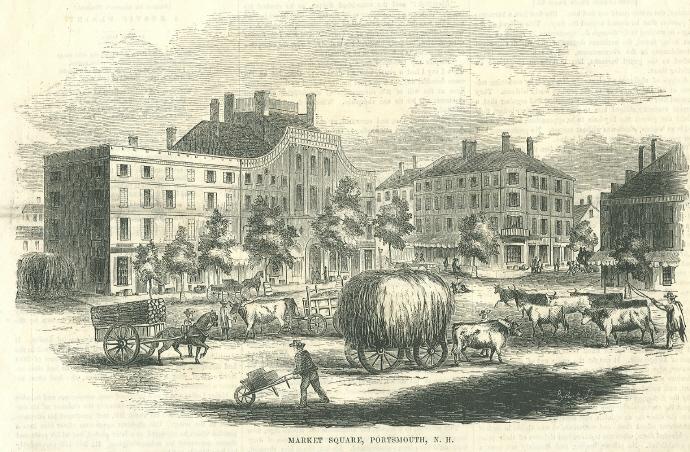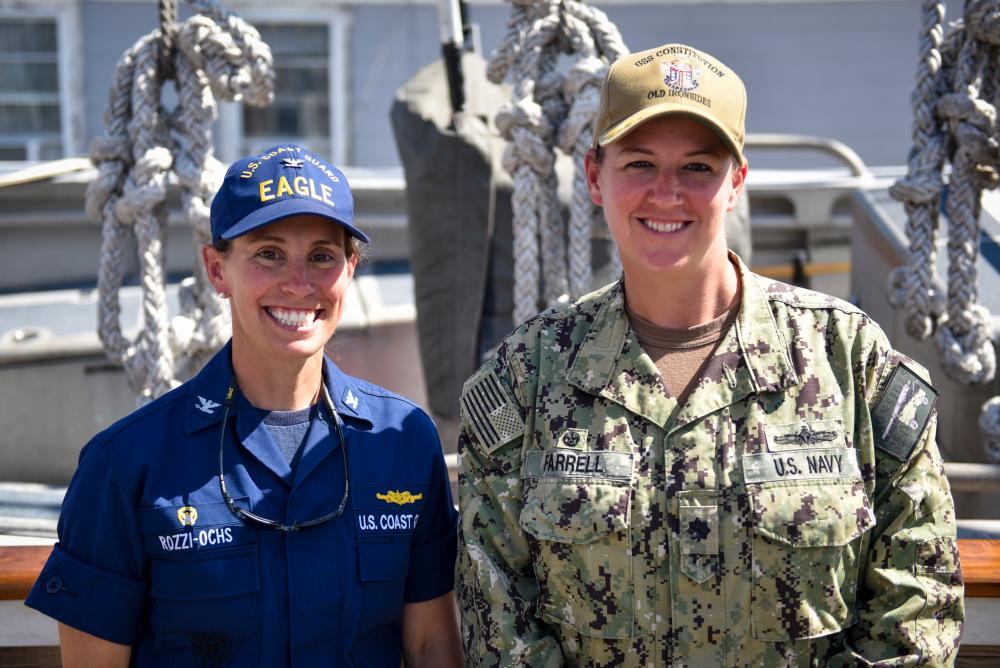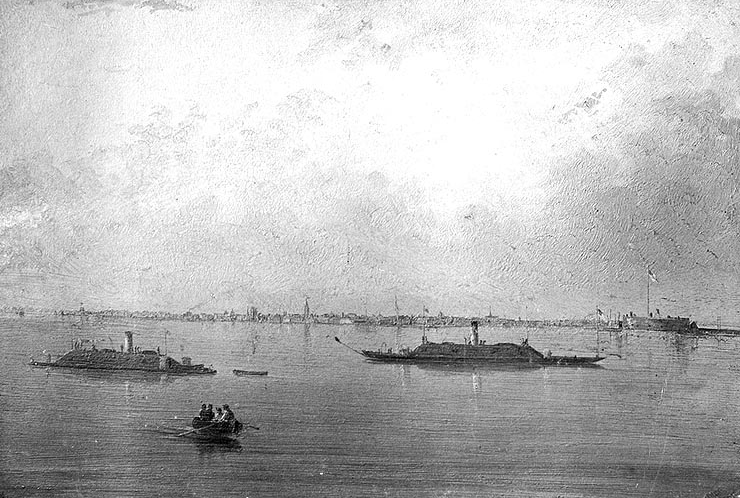|
Enoch Greenleafe Parrott
Enoch Greenleafe Parrott (December 10, 1814 – May 10, 1879) was an American naval officer who fought in the Mexican-American War and Civil War, later rising to the rank of rear admiral. Biography Parrott was born in Portsmouth, New Hampshire, on December 10, 1814. He entered the United States Navy in 1831 as a midshipman, and was promoted to lieutenant in 1841. In 1843 he took part in the anti-slavery expedition of Commander Matthew C. Perry's Africa Squadron. During the Mexican-American War he served aboard the 52-gun frigate , and took part in John C. Frémont's expedition from Monterey to Los Angeles, and in the capture of Guaymas and Mazatlán. Parrott was commissioned as commander in 1861 at the beginning of the Civil War, and was involved in the destruction of Norfolk Navy Yard before it could be taken over by the Confederacy. In the brig he captured the Confederate privateer ''Savannah'', for which he received the commendation of the Navy Department. He commanded the ... [...More Info...] [...Related Items...] OR: [Wikipedia] [Google] [Baidu] |
Portsmouth, New Hampshire
Portsmouth is a city in Rockingham County, New Hampshire, United States. At the 2020 census it had a population of 21,956. A historic seaport and popular summer tourist destination on the Piscataqua River bordering the state of Maine, Portsmouth was formerly the home of the Strategic Air Command's Pease Air Force Base, since converted to Portsmouth International Airport at Pease. History American Indians of the Abenaki and other Algonquian languages-speaking nations, and their predecessors, inhabited the territory of coastal New Hampshire for thousands of years before European contact. The first known European to explore and write about the area was Martin Pring in 1603. The Piscataqua River is a tidal estuary with a swift current, but forms a good natural harbor. The west bank of the harbor was settled by European colonists in 1630 and named Strawbery Banke, after the many wild strawberries growing there. The village was protected by Fort William and Mary on what is now ... [...More Info...] [...Related Items...] OR: [Wikipedia] [Google] [Baidu] |
Norfolk Navy Yard
The Norfolk Naval Shipyard, often called the Norfolk Navy Yard and abbreviated as NNSY, is a U.S. Navy facility in Portsmouth, Virginia, for building, remodeling and repairing the Navy's ships. It is the oldest and largest industrial facility that belongs to the U.S. Navy as well as the most comprehensive. Located on the Elizabeth River, the yard is just a short distance upriver from its mouth at Hampton Roads. It was established as Gosport Shipyard in 1767. Destroyed during the American Revolutionary War, it was rebuilt and became home to the first operational drydock in the United States in the 1830s. Changing hands during the American Civil War, it served the Confederate States Navy until it was again destroyed in 1862, when it was given its current name. The shipyard was again rebuilt, and has continued operation through the present day. History British control The Gosport Shipyard was founded on November 1, 1767 by Andrew Sprowle on the western shore of the Elizabeth Rive ... [...More Info...] [...Related Items...] OR: [Wikipedia] [Google] [Baidu] |
1879 Deaths
Events January–March * January 1 – The Specie Resumption Act takes effect. The United States Note is valued the same as gold, for the first time since the American Civil War. * January 11 – The Anglo-Zulu War begins. * January 22 – Anglo-Zulu War – Battle of Isandlwana: A force of 1,200 British soldiers is wiped out by over 20,000 Zulu warriors. * January 23 – Anglo-Zulu War – Battle of Rorke's Drift: Following the previous day's defeat, a smaller British force of 140 successfully repels an attack by 4,000 Zulus. * February 3 – Mosley Street in Newcastle upon Tyne (England) becomes the world's first public highway to be lit by the electric incandescent light bulb invented by Joseph Swan. * February 8 – At a meeting of the Royal Canadian Institute, engineer and inventor Sandford Fleming first proposes the global adoption of standard time. * March 3 – United States Geological Survey is founded. * March 11 – The ... [...More Info...] [...Related Items...] OR: [Wikipedia] [Google] [Baidu] |
1814 Births
Events January * January 1 – War of the Sixth Coalition – The Royal Prussian Army led by Gebhard Leberecht von Blücher crosses the Rhine. * January 3 ** War of the Sixth Coalition – Siege of Cattaro: French garrison surrenders to the British after ten days of bombardment. ** War of the Sixth Coalition – Siege of Metz: Allied armies lay siege to the French city and fortress of Metz. * January 5 – Mexican War of Independence – Battle of Puruarán: Spanish Royalists defeat Mexican Rebels. * January 11 – War of the Sixth Coalition – Battle of Hoogstraten: Prussian forces under Friedrich Wilhelm Freiherr von Bülow defeat the French. * January 14 ** Treaty of Kiel: Frederick VI of Denmark cedes the Kingdom of Norway into personal union with Sweden, in exchange for west Pomerania. This marks the end of the real union of Denmark-Norway. ** War of the Sixth Coalition – Siege of Antwerp: Allied forces besiege French Ant ... [...More Info...] [...Related Items...] OR: [Wikipedia] [Google] [Baidu] |
Edmund Colhoun
Edmund Ross Colhoun (6 May 1821 – 17 February 1897) was a rear admiral of the United States Navy who served during the Mexican War and the American Civil War, in which he was commended for his participation in the bombardment and capture of Fort Fisher. Naval career Service from 1839 to 1853 Colhoun was born at Chambersburg, Pennsylvania, on 6 May 1821 and was appointed a midshipman on 1 April 1839. He was attached to the sloop-of-war in the Brazil Squadron from 1839 to 1841, then to the frigate in the Mediterranean Squadron and Brazil Squadron from 1842 to 1844. He then attended the Philadelphia Naval School in Philadelphia, Pennsylvania, in 1845 and, after completing his studies, was promoted to passed midshipman on 2 July 1845. Colhoun next served aboard the frigate from 1846 to 1847, seeing action in the Mexican War, first under Commodore David Conner in the first attack on Alvarado, Mexico, and then under Commodore Matthew C. Perry at Tabasco, Mexico. From 1850 ... [...More Info...] [...Related Items...] OR: [Wikipedia] [Google] [Baidu] |
Thornton A
Thornton or ''variant'', may refer to: People *Thornton (surname), people with the surname ''Thornton'' *Justice Thornton (other), judges named "Thornton" *Thornton Wilder, American playwright Places Australia *Thornton, New South Wales * Thornton, Queensland, a locality in the Lockyer Valley Region * Thornton, South Australia, a former town * Thornton, Victoria Canada *Thornton, Ontario New Zealand * Thornton, Bay of Plenty, settlement in the Bay of Plenty * Thornton, Waikato, suburb of Hamilton * Thornton Bay, settlement on the Coromandel Peninsula South Africa * Thornton, Cape Town United Kingdom * Thornton, Angus, a location *Thornton, Buckinghamshire *Thornton, East Riding of Yorkshire *Thornton, Fife *Thornton, Lancashire * Thornton, Leicestershire *Thornton, Lincolnshire *Thornton, Merseyside * Thornton, Northumberland, a location *Thornton, Middlesbrough, North Yorkshire *Thornton, Pembrokeshire *Thornton, West Yorkshire *Thornton Abbey, Lincolnshire ... [...More Info...] [...Related Items...] OR: [Wikipedia] [Google] [Baidu] |
Asiatic Squadron
The Asiatic Squadron was a squadron of United States Navy warships stationed in East Asia during the latter half of the 19th century. It was created in 1868 when the East India Squadron was disbanded. Vessels of the squadron were primarily involved in matters relating to American commerce with China and Japan, though it participated in several conflicts over 34 years of service until becoming the Asiatic Fleet in 1902. History Korean Expedition In May 1871, Rear Admiral John Rodgers went to Korea, commanding an expedition of five Asiatic Squadron vessels, the screw frigate , the screw sloops-of-war and , the sidewheel gunboat , and the screw tug . The objective of the operation was to ascertain the fate of the merchant ship SS ''General Sherman'', establish trade relations, and receive an assurance from the Joseon government that shipwrecked American sailors would be safely treated should they become stranded in Korea. On 1 June 1871, while Rear Admiral Rodgers was ... [...More Info...] [...Related Items...] OR: [Wikipedia] [Google] [Baidu] |
Commodore (United States)
Commodore was an early title and later a rank in the United States Navy, United States Coast Guard and the Confederate States Navy, and also has been a rank in the United States Public Health Service Commissioned Corps and the National Oceanic and Atmospheric Administration Commissioned Officer Corps (NOAA Corps) and its ancestor organizations. For over two centuries, the designation has been given varying levels of authority and formality. Today, it is no longer a specific rank within active-duty or reserve forces or in the Public Health Service Commissioned Corps or NOAA Corps, but it remains in use as an ''honorary title'' within the U.S. Navy and U.S. Coast Guard for those senior captains (pay grade O-6) in command of operational organizations composed of multiple independent subordinate naval units (e.g., multiple independent ships or aviation squadrons). However, "commodore" is a rank that is actively used to this day in the United States Coast Guard Auxiliary, the civ ... [...More Info...] [...Related Items...] OR: [Wikipedia] [Google] [Baidu] |
Captain (United States O-6)
In the United States Navy, United States Coast Guard, United States Public Health Service Commissioned Corps (USPHS), and National Oceanic and Atmospheric Administration Commissioned Officer Corps (NOAA Corps), captain is the senior-most commissioned officer rank below that of flag officer (i.e., admirals). The equivalent rank is colonel in the United States Army, Air Force, Space Force, and Marine Corps. Reflecting its nautical heritage, the term ''captain'' is used as a military title by more junior officers who command a commissioned vessel of the Navy, Coast Guard, or National Oceanic and Atmospheric Administration (NOAA) ship of patrol boat size or greater. Officers below O-6 who command aviation squadrons (typically O-5 commanders) usually use the less formal title "skipper". Insignia File:US-O6 insignia.svg, USN, USCG, USPHSCC, and NOAACOC collar, cover (hat), or shoulder rank insignia (on select uniforms) File:US Navy O6 insignia.svg, The eagle, shoulder boards, an ... [...More Info...] [...Related Items...] OR: [Wikipedia] [Google] [Baidu] |
Charleston, South Carolina
Charleston is the largest city in the U.S. state of South Carolina, the county seat of Charleston County, and the principal city in the Charleston–North Charleston metropolitan area. The city lies just south of the geographical midpoint of South Carolina's coastline on Charleston Harbor, an inlet of the Atlantic Ocean formed by the confluence of the Ashley, Cooper, and Wando rivers. Charleston had a population of 150,277 at the 2020 census. The 2020 population of the Charleston metropolitan area, comprising Berkeley, Charleston, and Dorchester counties, was 799,636 residents, the third-largest in the state and the 74th-largest metropolitan statistical area in the United States. Charleston was founded in 1670 as Charles Town, honoring King CharlesII, at Albemarle Point on the west bank of the Ashley River (now Charles Towne Landing) but relocated in 1680 to its present site, which became the fifth-largest city in North America within ten years. It remained unincorpor ... [...More Info...] [...Related Items...] OR: [Wikipedia] [Google] [Baidu] |
James River (Virginia)
The James River is a river in the U.S. state of Virginia that begins in the Appalachian Mountains and flows U.S. Geological Survey. National Hydrography Dataset high-resolution flowline dataThe National Map , accessed April 1, 2011 to Chesapeake Bay. The river length extends to if one includes the Jackson River, the longer of its two source tributaries. It is the longest river in Virginia. Jamestown and Williamsburg, Virginia's first colonial capitals, and Richmond, Virginia's current capital, lie on the James River. History The Native Americans who populated the area east of the Fall Line in the late 16th and early 17th centuries called the James River the Powhatan River, named for the chief of the Powhatan Confederacy which extended over most of the Tidewater region of Virginia. The Jamestown colonists who arrived in 1607 named it "James" after King James I of England (), as they constructed the first permanent English settlement in the Americas at Jamestown along th ... [...More Info...] [...Related Items...] OR: [Wikipedia] [Google] [Baidu] |
CSS Chicora
CSS ''Chicora'' was a Confederate ironclad ram that fought in the American Civil War. It was built under contract at Charleston, South Carolina in 1862. James M. Eason built it to John L. Porter's plans, using up most of a $300,000 State appropriation for construction of marine batteries; Eason received a bonus for "skill and promptitude." Its iron shield was thick, backed by of oak and pine, with armor at its ends. Keeled in March, it was commissioned in November, Commander John Randolph Tucker, CSN assuming command. In thick, predawn haze on January 31, 1863, ''Chicora'' and raided the Federal blockading force of unarmored ships lying just outside the entrance to Charleston Harbor. With ram and gun, ''Palmetto State'' forced to surrender, then disabled , who had to be towed to safety. ''Chicora'' meanwhile engaged other Union ships in a long-range gun duel, from which it emerged unscathed to withdraw victoriously to shelter inside the harbor. It took part in the defens ... [...More Info...] [...Related Items...] OR: [Wikipedia] [Google] [Baidu] |








